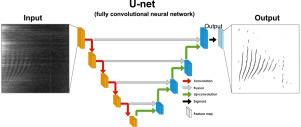当前位置:
X-MOL 学术
›
Comput. Geosci.
›
论文详情
Our official English website, www.x-mol.net, welcomes your feedback! (Note: you will need to create a separate account there.)
Automatic detection of Ionospheric Alfvén Resonances in magnetic spectrograms using U-net
Computers & Geosciences ( IF 4.4 ) Pub Date : 2020-12-01 , DOI: 10.1016/j.cageo.2020.104598 Paolo Marangio , Vyron Christodoulou , Rosa Filgueira , Hannah F. Rogers , Ciarán D. Beggan
Computers & Geosciences ( IF 4.4 ) Pub Date : 2020-12-01 , DOI: 10.1016/j.cageo.2020.104598 Paolo Marangio , Vyron Christodoulou , Rosa Filgueira , Hannah F. Rogers , Ciarán D. Beggan

|
Abstract Ionospheric Alfven Resonances (IARs) are weak discrete non-stationary Alfven waves along magnetic field lines, at periods of ∼ 0.5–20 Hz, that occur during local night-time, particularly during low geomagnetic activity. They are detectable through time–frequency analysis (spectrograms) of measurements made by sensitive search coil magnetometers. The IARs are generated by the interaction of electromagnetic energy partially trapped in the Earth–ionosphere cavity with the main geomagnetic field and their behaviour provides proxy information about atmospheric ion density between 100–1000 km altitude. Limited methods exist to automatically detect and analyse their properties and behaviour as they are difficult to extract using standard image and signal processing techniques. We present a new method for the detection of IARs based on the fully convolutional neural network U-net. U-net was chosen as it is able to perform accurate image segmentation and it can be trained in a supervised fashion on a relatively small labelled dataset utilizing data augmentation. We show that the resulting predictive model generated by training the U-net is able to detect IAR signals while mislabelling considerably less noise than other data analysis methods. We achieved our best results by using a training set of 178 hand-digitized examples from high-quality spectrograms measured at the Eskdalemuir Geophysical Observatory (UK). We find that the network converges in ten iterations with a final intersection over union (IoU) metric of 0.9 and a training loss of below 0.2. We use the trained network to extract IARs from over 2300 images, covering six years of search coil magnetometer data measured at the Eskdalemuir Observatory. U-net can also automatically handle missing data or days without IARs, giving a null result as expected. This constitutes the first use of a neural network for pattern recognition of unstructured image data such as spectrograms containing IAR signals, though the method is applicable to other types of resonances or geophysical features in the time–frequency domain.
中文翻译:

使用 U-net 自动检测磁谱图中电离层阿尔文共振
摘要 电离层阿尔文共振 (IAR) 是沿磁场线的弱离散非平稳阿尔文波,周期约为 0.5-20 Hz,发生在局部夜间,特别是在低地磁活动期间。它们可以通过敏感搜索线圈磁力计进行的测量的时频分析(频谱图)检测到。IAR 是由部分困在地球-电离层空腔中的电磁能与主要地磁场相互作用而产生的,它们的行为提供了有关 100-1000 公里高度之间大气离子密度的代理信息。由于使用标准图像和信号处理技术难以提取它们,因此存在有限的方法来自动检测和分析它们的特性和行为。我们提出了一种基于全卷积神经网络 U-net 检测 IAR 的新方法。选择 U-net 是因为它能够执行准确的图像分割,并且可以利用数据增强在相对较小的标记数据集上以监督方式进行训练。我们表明,通过训练 U-net 生成的预测模型能够检测 IAR 信号,同时错误标记的噪声比其他数据分析方法少得多。我们通过使用来自 Eskdalemuir 地球物理天文台(英国)测量的高质量光谱图的 178 个手工数字化示例的训练集获得了最佳结果。我们发现网络在十次迭代中收敛,最终的联合交集 (IoU) 度量为 0.9,训练损失低于 0.2。我们使用经过训练的网络从 2300 多张图像中提取 IAR,涵盖了在 Eskdalemuir 天文台测量的六年搜索线圈磁力计数据。U-net 还可以自动处理缺失数据或没有 IAR 的天数,按预期给出空结果。这构成了神经网络首次用于非结构化图像数据的模式识别,例如包含 IAR 信号的频谱图,尽管该方法适用于其他类型的共振或时频域中的地球物理特征。
更新日期:2020-12-01
中文翻译:

使用 U-net 自动检测磁谱图中电离层阿尔文共振
摘要 电离层阿尔文共振 (IAR) 是沿磁场线的弱离散非平稳阿尔文波,周期约为 0.5-20 Hz,发生在局部夜间,特别是在低地磁活动期间。它们可以通过敏感搜索线圈磁力计进行的测量的时频分析(频谱图)检测到。IAR 是由部分困在地球-电离层空腔中的电磁能与主要地磁场相互作用而产生的,它们的行为提供了有关 100-1000 公里高度之间大气离子密度的代理信息。由于使用标准图像和信号处理技术难以提取它们,因此存在有限的方法来自动检测和分析它们的特性和行为。我们提出了一种基于全卷积神经网络 U-net 检测 IAR 的新方法。选择 U-net 是因为它能够执行准确的图像分割,并且可以利用数据增强在相对较小的标记数据集上以监督方式进行训练。我们表明,通过训练 U-net 生成的预测模型能够检测 IAR 信号,同时错误标记的噪声比其他数据分析方法少得多。我们通过使用来自 Eskdalemuir 地球物理天文台(英国)测量的高质量光谱图的 178 个手工数字化示例的训练集获得了最佳结果。我们发现网络在十次迭代中收敛,最终的联合交集 (IoU) 度量为 0.9,训练损失低于 0.2。我们使用经过训练的网络从 2300 多张图像中提取 IAR,涵盖了在 Eskdalemuir 天文台测量的六年搜索线圈磁力计数据。U-net 还可以自动处理缺失数据或没有 IAR 的天数,按预期给出空结果。这构成了神经网络首次用于非结构化图像数据的模式识别,例如包含 IAR 信号的频谱图,尽管该方法适用于其他类型的共振或时频域中的地球物理特征。



























 京公网安备 11010802027423号
京公网安备 11010802027423号